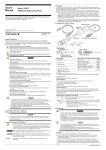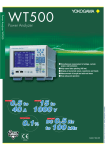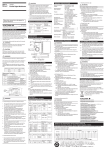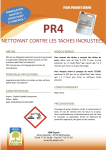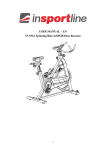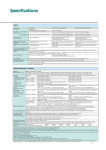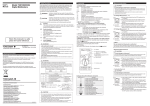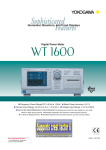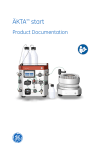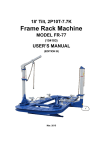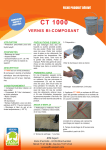Download CT1000, CT200, CT60 AC/DC Current Sensor User`s Manual
Transcript
1. Description This device is a current output type current sensor with a 1500:1(for CT1000) 1000:1(for CT200) or 600:1(for CT60) current transformation ratio that performs transformation on the primary current. After familiarizing yourself with the performance and functions of this device, you will be able to use it in conjunction with measuring instruments from YOKOGAWA. CT1000,CT200,CT60 AC/DC Current Sensor User's Manual 2. Configuration The current sensor consists of the following parts. Standard parts 1. Current sensor 2. User’s manual Thank you for purchasing the AC/DC Current Sensor (Model CT1000,CT200,CT60). To ensure correct use, please read this manual thoroughly before beginning operation. After reading this manual, keep it in a safe place. Accessories sold separately Output connector Load resistors B8200JQ B8200JR 3. Part Names Attachment screw holes (two M6) Top 2nd Edition: January 2012 (YMI) All Rights Reserved, Copyright © 2010, Yokogawa Meters & Instruments Corporation Printed in Japan Attachment screw holes (four M5) IM CT1000-01EN 2nd Edition Secondary connector Front 9 Safety Precautions Pin assignment 5 Primary conductor feed-through hole Make sure to observe the following safety precautions when handling the current sensor. YOKOGAWA assumes no liability for the customer’s failure to comply with these safety precautions. Before you use the current sensor, read the measuring instrument’s manual to fully acquaint yourself with its specifications and handling. The following symbols are used on this instrument. Warning: handle with care. Refer to the user’s manual or service manual. This symbol appears on dangerous locations on the instrument which require special instructions for proper handling or use. The same symbol appears in the corresponding place in the manual to identify those instructions. Risk of electric shock 1 6 Signal Output return [Do not connect] [Do not connect] 0 V Power Supply Input –15 V Power Supply Input Secondary Signal Output [Do not connect] [Do not connect] +15 V Power Supply Input CT1000 Attachment screw holes (two M5) Attachment screw holes (two M5) Top Attachment screw holes (four M4) Secondary connector Make sure to observe the following safety precautions to prevent electric shock, personal injury, or damage to the instrument. 1 Front Conductor guide CT200 (This directive is only valid in the EU.) This product complies with the WEEE Directive (2002/96/EC) marking requirement. This marking indicates that you must not discard this electrical/electronic product in domestic household waste. Product Category With reference to the equipment types in the WEEE directive Annex 1, this product is classified as a “Monitoring and Control instrumentation” product. Do not dispose in domestic household waste. When disposing products in the EU, contact your local Yokogawa Europe B. V. office. 4. Operating Procedure CAUTION Ensure that the current flowing to the conductor of the object to be measured is within the measuring range. If the current exceeds the measuring range, the device may overheat and get damaged. 1. Connect the secondary connector on the device to the current input terminal on the measuring instrument, and connect to 0 V (common) and ±15 V on the power supply. 2. Set up the measuring instrument and power supply to match the specifications of the current transducer. Carefully read the user’s manuals for your measuring instrument and power supply to perform the correct procedure for making the connections. Secondary connector of the current sensor 6 이 기기는가정용 (B 급 ) 전자파 적합 기기입니다 The product is for home use (Class B) and meets the electromagnetic compatibility requirements. KCC-REM-IMY-EEN314 Current Sensor Yokogawa Meters & Instruments Corporation Yokogawa Meters & Instruments Corporation Denmark Measuring instrument Rb Rb: Load resistor* Current input terminal 1 Power supply 4 5 9 0 V(common) –15 V +15 V * Make sure that the total load resistance including measuring instrument's internal resistance and external load resistance (Rb) is within the specification. Figure 2. Connection Example 3. Insert the primary conductor into the primary conductor feed-through hole on the device. Make sure that the direction of current flow matches the arrow on the device. Figure 3 is for the examples in use with CT200 and CT60. The same idea is applied to CT1000 as well. Correct Conductor Incorrect Direction of current Using an magnetic -shielded conductor Using two parallel conductors Primary current Current flows in both directions Figure 3. Insertion of a Conductor 4. Check that power is being supplied to the device, and then apply the primary current. 5. Read the measured values. The following calculation is used to determine the current flowing through the primary conductor. Example: When the output current from the device's secondary connector (pin 6) is 100 mA. CT1000: 100 mA x 1500 = 150 A. CT200: 100 mA x 1000 = 100 A. CT60: 100 mA x 600 = 60 A. Note • • Compliance with the Radio Waves Act (Republic of Korea) This product complies with the Radio Waves Act (Republic of Korea). Note the following when using the product in Republic of Korea. CT60 Figure 1. Names of Parts and Pin Assignments Calls attention to information that is important for proper operation of the instrument. Directive 2002/96/EC Pin assignment Primary conductor feed-through hole The following symbols are used in this manual. Improper handling or use can lead to injury to the user or damage to the instrument. This symbol appears on the instrument to indicate that the user must refer to the user’ s manual for special instructions. The same symbol appears in the corresponding place in the user’s manual to identify those instructions. In the manual, the symbol is used in conjunction with the word “WARNING” or “CAUTION.” WARNING Calls attention to actions or conditions that could cause serious or fatal injury to the user, and precautions that can be taken to prevent such occurrences. CAUTION Calls attention to actions or conditions that could cause light injury to the user or damage to the instrument or the user’s data, and precautions that can be taken to prevent such occurrences. 5 6 9 WARNING • Beware of electric shock. • Do not perform measurement if the case is damaged. • Do not operate the device with wet hands, in a rainy or humid environment, or if any water droplets are visible on it. • Condensation may appear if sudden changes in temperature occur. If this happens, let the device acclimatize to the new temperatures for at least one hour, then refrain from using the device until confirming that there is no condensation. • Do not disassemble the device. The device should be disassembled by qualified personnel only. • Use the correct power supply. Ensure that the source voltage matches the voltage of the power supply before turning the power ON. • Do not use uninsulated measurement conductors or cables. Use conductors or cables with reinforced insulation. • Make sure that the surface temperature of measurement conductors is within the device's operating temperature range. • Although it is well-insulated, do not touch the device or secondary output cable while voltage is being applied to the primary conductor. • Connect the secondary signal output before supplying power to the device. • Do not disconnect the secondary output while power is being supplied to the device to prevent electric shock or damage to the instrument. • Do not apply primary current before supplying power to the device to prevent electric shock or damage to the instrument. • Do not input excessive current as malfunction or damage may result. • Do not allow vibrations to disturb the device after it has been set in place as damage may result. Registration No: Equipment Name: Trade Name: Manufacturer: Country of Origin: Pin No. 1 2 3 4 5 6 7 8 9 Conductor guide Hot surface Note Signal allocation of secondary connector • If the NORMAL OPERATION LED is off even when power is being supplied to the device, the protection function may be activated. Immediately stop the primary current. Only pass conductors through the primary conductor feed-through hole if the current that you want to measure is flowing through the conductors and their current directions are the same. Correct measurements cannot be taken if you pass conductors with magnetic shielding or conductors whose current directions are opposite of each other through the feed-through hole. Make sure the primary wiring and secondary wiring do not interfere with each other. The secondary wiring may be affected by the primary wiring because it uses a very small current. Make the secondary wiring as short as possible and maintain its distance from the primary wiring, without allowing them to be parallel to each other. We recommend AWG24 or higher for the secondary wiring material. Twisted-pair may be better than shielded cable for measurement applications such as inverters. IM CT1000-01EN 1/2 Maximum Allowable Input Current [Arms] 10000 100000 100000 Figure 4. Derating of Primary Current by Frequency CT1000 Unit: mm 2-Ф6.5 hole 109 104 90 4-Ф5.5 hole Ф30 54 128 CT200, CT60 2-Ф5.5 hole Ф30 Max 80 93 76 77.3 Ф26 Min Unless otherwise specified, tolerances are ±3% (however, tolerances are ± 0.3 mm when below 10 mm). Figure 5. External Dimensions 6. Servicing 7. Warranty If you experience a breakdown in the device due to faulty manufacturing or accidents during shipping, contact your nearest YOKOGAWA dealer. 100 8. 产品中有毒有害物质或元素的名称及含量 This section is valid in China only. 10 部件名称 1 1 10 100 1000 Frequency [Hz] 10000 100000 100000 CT200 1000 Maximum Allowable Input Current [Arms] 1000 Frequency [Hz] If you encounter any problems during use, or if the device does not appear to be operating normally, contact your nearest YOKOGAWA dealer. CT1000 1000 100 9 Accuracy warranty period Effect of Position of Conductor Measurement Band (-3dB) Temperature Coefficient In the 10 to 18°C, 28 to 50°C ranges: 0.01%/°C Max. Allowable Continuous Input 1000 Apeak 200 Apeak 60 Apeak Derating of Max. Allowable Input For the maximum allowable continuous current with respect to frequency, see figure 4. Instantaneous Max. Allowable 4500 Apeak 1000 Apeak 300 Apeak Input (0.1 sec. or less, reference value) Maximum Rated Voltage 1000 Vrms CAT III Load Resistance 2.5 to 5 Ω 0 to 30 Ω 0 to 20 Ω Operating Temperature 10 to 50°C environment Humidity 20 to 80%RH (no condensation) Altitude 2000 m or less Storage Temperature -20 to 60°C environment Humidity 20 to 80% RH (No condensation) Altitude 3000 m or less External Dimensions Approx. 128(W) x Approx. 93(W) x 77(H) x 38(D) mm 106(H) x 60(D) mm (excluding the connector and conductor guide) Diameter of Primary Current Hole φ30 mm φ26 mm Secondary Connector D-Sub 9 pin Weight Approx. 0.8 kg. Approx. 0.3 kg. Power Supply Voltage ±(15 V ± 5%) Maximum Rated Power 30 VA 11 VA 7 VA Consumption Current Consumption (at Power Approx. (150 mA + Approx. (80 mA + output current) Supply Voltage) output current) Recommended fastening torque •Flat mounting M5×4 steel screws M4×4 steel screws 3.7 Nm 2.8 Nm •Straight mounting M6×2 steel screws M5×2 steel screws 4.4 Nm 3.7 Nm Safety standard Compliant standards EN61010-1 Emissions Compliant standards E N61326-1 ClassB, EN55011 ClassB, Group1 C-tick EN55011 ClassB, Group1 Immunity Compliant standards EN61326-1 Table 2 (for industrial locations) Accessories User’s manual: 1 pc. Opt. Accessories (Sold •D-Sub 9 pin connector (plug, part number B8200JQ): 1 pc. Separately) •Load resistor (four 10-Ω resistors, part number B8200JR, accuracy of resistance value ±0.1%, temp. coefficient 25 ppm/°C): 1 group. Example: To apply a 2.5 Ω load resistance, connect the four 10 Ω resistors in parallel. 10 38.8 Current Transformation Ratio Direction of Current Accuracy 1 30 Output Current 1 60 Current Rating Model CT1000 CT200 CT60 DC: 0 to 1000 A DC: 0 to 200 A DC: 0 to 60 A AC: 1000 Apeak AC: 200 Apeak AC: 60 Apeak Primary rated current Primary rated current Primary rated current at 1000 A is 666.6 mA. at 200 A is 200.0 mA. at 60 A is 100.0 mA. 1500:1 1000:1 600:1 Per the arrow printed on the main unit. DC: ±(0.05% of reading+30 μA) 50/60 Hz: ±(0.05% of reading+30 μA) sine wave Standard Conditions 23±5°C Common mode voltage:0 V Conductor: φ25 mm; length,300 mm or more; straight 12 months Add ±(0.01% of reading) DC to 300 kHz DC to 500 kHz DC to 800 kHz 85 Item 20.3 5. Specifications 10 67 • 106 • CT60 100 38 The device outputs current. Connect the device to a measuring instrument with current input. To connect the device to a measuring instrument with voltage input, use an appropriate shunt resistor to connect the device to the voltage input terminals. Configure your setup so that the load resistance of the measuring instrument connected to the secondary signal output is within the specification range. Correct measurements may not be possible in places where there is an extremely strong external magnetic field besides the magnetic fields produced by the primary current of the object to be measured or where there is a strong electric field. Maximum Allowable Input Current [Arms] • 100 有毒有害物质或元素 铅 汞 镉 六价铬 多溴联苯 多溴二苯醚 (Pb) (Hg) (Cd)(Cr(VI))(PBB) (PBDE) 框架(塑料) ○ ○ ○ ○ ○ ○ ○ ○ ○ ○ ○ 框架(金属) ○ 线路板 ○ ○ ○ ○ ○ ○ ASSY ○:表示该有毒有害物质在该部件所有均质材料中的含量均在 SJ/T 11363-2006 标准规定的限量要求以下。 ×:表示该有毒有害物质至少在该部件的某一均质材料中的含量超 出 SJ/T 11363-2006 标准规定的限量要求。 9. 环保使用期限 10 This section is valid in China only. 表示该有毒有害物质在该产品中的含量均在 SJ/T 11363-2006 标准规定的限量要 求以下。 1 1 10 IM CT1000-01EN 2/2 100 1000 Frequency [Hz] 10000 100000 100000



